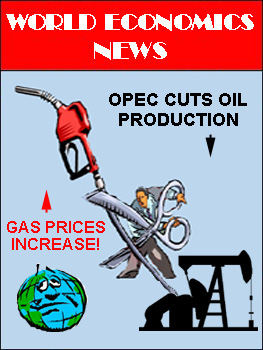 March
25, 2000 Oil and gas prices have been increasing this year, and
they
surged upward dramatically earlier this month. The NYMEX sweet
crude
oil price peaked at $34 per barrel on March 7, and the price is still
above
$30 at this writing. NYMEX wholesale unleaded gasoline
prices
went briefly above $1.00 per gallon. They have decreased somewhat
since then but are still above 90 cents. In some parts of the
United
States, retail prices for unleaded gasoline are above $2.00 per
gallon, setting record highs!
March
25, 2000 Oil and gas prices have been increasing this year, and
they
surged upward dramatically earlier this month. The NYMEX sweet
crude
oil price peaked at $34 per barrel on March 7, and the price is still
above
$30 at this writing. NYMEX wholesale unleaded gasoline
prices
went briefly above $1.00 per gallon. They have decreased somewhat
since then but are still above 90 cents. In some parts of the
United
States, retail prices for unleaded gasoline are above $2.00 per
gallon, setting record highs!
The recent price increases are attributed to the combination of
cutbacks
in oil production by the Organization of Petroleum Exporting Countries
(OPEC) and increased demand as the world economy continues its economic
recovery from recession in the late 1990s.
When the prices of oil and gasoline go up, the world takes notice --
especially the world's big oil and gas consumers. The United
States
alone accounts for 25.6% of annual world oil consumption. Western
Europe accounts for another 20.4%, and Japan consumes 7.5%. In
the
newly industrializing countries (NICs) such as Korea and Taiwan and in
many less developed countries (LDCs), oil consumption has been
increasing
as a per cent of their GDPs. In the early 1970s emerging
economies
only accounted for 29% of total world oil consumption. Now they
account
for 43%. When the price of oil goes up, oil producers earn more
petrodollars
while oil and gas consumers pay more for less.
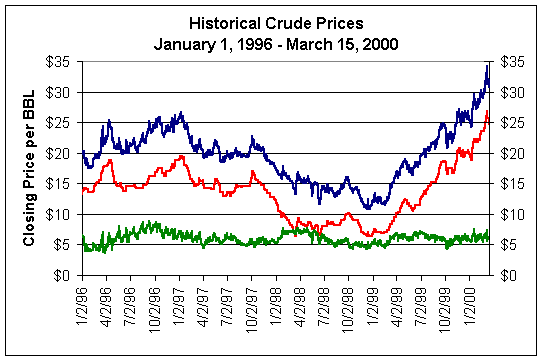
--- NYMEX Futures Price for West
Texas Immediate (WTI) crude oil
--- Posted Price for Heavy San
Joaquin Valley (SJV) crude oil
--- Spread between the two crude
oil prices
Source: Image is the property of
Berry Petroleum Company and is reproduced here with permission.
The graph above shows that oil prices fell to very low levels early
in 1999 but have been increasing steadily since then. As the two
graphs below demonstrate, oil and gasoline prices naturally tend to
move
together because oil is the raw material that is distilled or "cracked"
under pressure into gasoline.
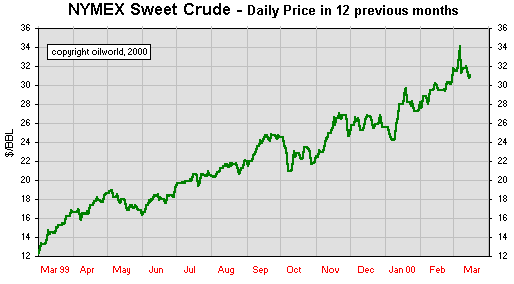
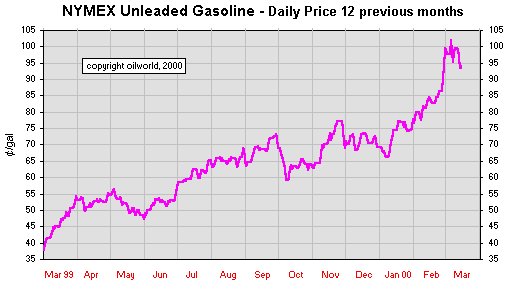
Source: Images are the property of Oil World.
They
are reproduced here with permission and through the courtesy of Oil
World.
Oil is the world's principal source of energy. It permeates
economic
activity in forestry, farming, mining, manufacturing, construction,
transportation,
and travel. Therefore, rising oil and gasoline prices have
the
potential to send an inflationary shock wave throughout the global
economy.
Many of us recall the oil shocks of 1973-74, 1979-80, and
1990.
In each of those instances economies around the world went into
recession
following the dramatic increases in the prices of oil and
gasoline.
More specifically, they experienced what is called stagflation -- the
combination of recession and inflation. The 1973-74 bout with
global
stagflation was particularly acute. Some experts are now warning
that the latest surge in oil and gas prices could cause another dose of
stagflation in the global economy later this year.
Does history repeat itself? Is it likely that the world will
experience
an acute case of stagflation in the months ahead? Well, the
answers
are "yes and no." Certain events like oil shocks do recur from
time
to time, but the prevailing economic conditions when they occur are
never
exactly the same. Some experts are predicting that the current
oil
shock is likely to be rather benign in the context of recent trends and
the current state of the global economy.
An article in the March 11 edition of The Economist magazine
(page 77) warns of the possibility of another nasty encounter with
global
stagflation. However, it also cites four "good reasons to think
that
the economic consequences of the jump in oil prices will be less severe
than they were in the 1970s": (1) The recent surge in oil prices comes
at a time when oil prices were at their lowest level in real
terms
(i.e., adjusted for inflation) since 1972. Even after the
latest
round of price increases, real oil prices are barely half their 1981
level
--[See Graph Below]. (2) Industrialized economies are much less
dependent
on oil than they used to be. Their consumption of oil expressed
as
a percentage of of GDP is just over half what it was in 1972.
Shifts
to other fuels, the decline in manufacturing, and changing consumer
behavior
over the past 25 years account for this decrease. (3) Attributing
this third point to J.P. Morgan economist Philip Suttle, The
Economist
notes that previous oil price hikes were associated with wars that
added
an element of uncertainty. This time oil production is being cut
back voluntarily by OPEC in the absence of a military encounter
-- [See Graph Below]. (4) Previous oil shocks took place when the
rich economies were already overheating. In contrast, only the
United
States economy appears overheated at this time, while Europe and
especially
Japan currently have excess capacity. All of these points lead to
the conclusion that the recent surge in oil prices have the potential
to
slow the global economy down with a smaller effect on inflation than in
the past. It would appear that most countries are more likely to
get a future dose of mild
deceleration instead of acute stagflation
in the next twelve months.
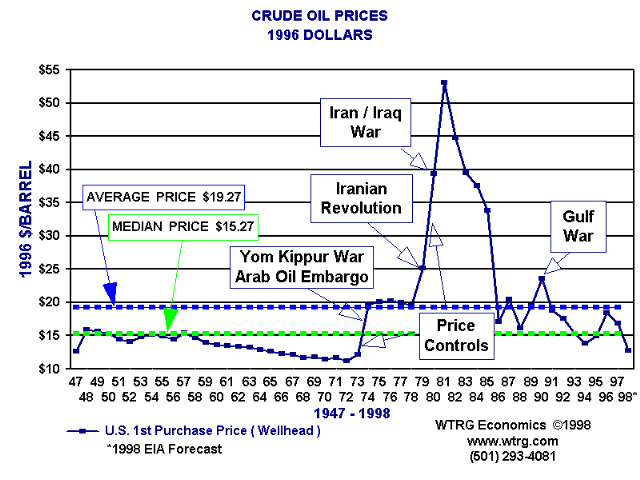
Source: Image is the property of WTRG Economics and is
reproduced here with permission and through the courtesy of WTRG
Economics.
********************
The Anatomy of Stagflation
 Stagflation
-- a recession combined with higher prices -- originates at the micro
level.
When the price of oil and gasoline goes up, each consumer is having to
pay more which leaves less income to spend on other goods and services
such as food, clothing, housing, furniture, electronics, insurance,
personal
care, entertainment, and medical services. When the consumer cuts
back spending on these other items, the economy begins to recede. If
the inflationary effects of higher oil and gas prices are greater than
the deflationary effects of declining demand for other goods and
services,
then the economy experiences stagflation. The reason that the
inflationary effects tend to outweigh the deflationary effects is that
the demand for oil and gasoline is inelastic. That means
that
the per cent increase in oil and gas prices is greater than the per
cent
decrease in the quantity demanded. The consumer literally spends
more money to purchase the same amount or less. (Note: If the
demand
for oil and gasoline were relatively elastic, then the consumer
would spend less of their disposable income on oil and gasoline when
their
prices increased because they would cut back their consumption of oil
and
gasoline to a greater degree than the increase in prices.
However,
economic studies consistently indicate that the demand for oil and
gasoline
is highly
inelastic).
Stagflation
-- a recession combined with higher prices -- originates at the micro
level.
When the price of oil and gasoline goes up, each consumer is having to
pay more which leaves less income to spend on other goods and services
such as food, clothing, housing, furniture, electronics, insurance,
personal
care, entertainment, and medical services. When the consumer cuts
back spending on these other items, the economy begins to recede. If
the inflationary effects of higher oil and gas prices are greater than
the deflationary effects of declining demand for other goods and
services,
then the economy experiences stagflation. The reason that the
inflationary effects tend to outweigh the deflationary effects is that
the demand for oil and gasoline is inelastic. That means
that
the per cent increase in oil and gas prices is greater than the per
cent
decrease in the quantity demanded. The consumer literally spends
more money to purchase the same amount or less. (Note: If the
demand
for oil and gasoline were relatively elastic, then the consumer
would spend less of their disposable income on oil and gasoline when
their
prices increased because they would cut back their consumption of oil
and
gasoline to a greater degree than the increase in prices.
However,
economic studies consistently indicate that the demand for oil and
gasoline
is highly
inelastic).
Consider a typical consumer in the United States who spends about
$2.50
on motor fuel out of every $100.00 of disposable income, leaving $97.50
to spend on everything else. If we assume (for simplicity) that
the
demand for gasoline is perfectly inelastic, then an increase in the
price
of gasoline from $1.00 per gallon to $2.00 per gallon will force the
consumer
to spend $5.00 to buy the same amount of gasoline, leaving only $95.00
for everything else. Each consumer will cut back spending on
other
goods and services by $2.50 for every $100.00 of disposable income.
The phenomenon of each consumer spending more money for the same
amount
or less gasoline while cutting back consumption of other goods and
services,
combined with the fact that higher oil and gas prices are raising the
costs
of energy and power to producers of everything from transporting goods
by truck to lighting a baseball field at night, spreads throughout the
economic system. It soon begins to show up in the economy's
macroeconomic
performance measurements. In the absence of any other offsetting
effects, aggregate supply decreases and the macro economy drifts toward
stagflation. It is particularly disagreeable because real GDP
declines,
cyclical unemployment increases, and the general price level rises.
The picture below shows the playing field of The World Game
of
Economics. Stagflation
is depicted in the upper left corner. When an economy is in the
stagflation
corner, real GDP is falling and both unemployment and inflation are
rising.
The further into the corner an economy goes, the worse the stagflation
and the lower the score. (Red numbers are a negative score in the
game). When oil production is deliberately cut back to create a
shortage
as in the case of OPEC's recent action (or if other resources and raw
materials
are becoming increasingly scarce without offsetting technological
advances),
economies will drift toward the stagflation corner.
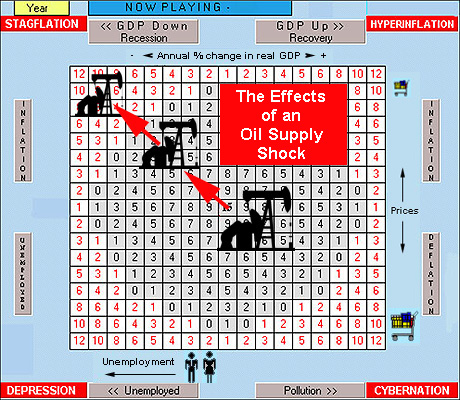
The extent to which an economy drifts toward the stagflation corner
due to an oil supply cutback depends on a number of factors: (1)
The higher the price of oil and gasoline goes relative to other prices,
the greater the adverse effects on an economy's GDP and inflation; (2)
The longer the duration of the price increase without offsetting
events,
the greater the impact; (3) The greater an economy's consumption of oil
and gasoline, especially as a per cent of its GDP, the more
severe
the stagflation will be for that country; (4) If an economy
already
has inflation or is in recession at the time of the oil shock, then the
oil and gas prices will exacerbate an already undesirable
situation.
It's likely that the effect on a country already in recession will be
less
on inflation and more on output and unemployment. (5) The higher the
concentration
of oil production, exports, refining, and distribution, the greater the
potential for inflationary effects of an oil shock on the world's
economies.
When we apply these generalizations to the current oil shock, we are
led to the conclusion that its effect will be remarkably different on
the
economies around the world. Were it not for the fact that oil
consumption
has declined to a relatively small per cent of its GDP, the United
States
economy would be the most vulnerable because of its sheer volume of oil
consumption and imports and the fact that its economy is already
operating
at full employment. It imports approximately 8.225 million
barrels
of oil per day and accounts for nearly one fourth of total world
imports.
However, it is sitting on 570 million barrels of government reserves,
which
the Clinton administration is considering releasing into the
market.
Japan, the world's second largest economy, is in a more precarious
position.
It imports all of its oil at about 4.584 million barrels per day, and
its
economy recorded negative growth in GDP in the 4th quarter of
1999.
The current increase in oil prices is likely to have much less impact
on
Japan's inflation rate than it will on dashing its hopes for economic
recovery.
Western Europe is likely to experience a little of both the "stag" and
"flation" in the term stagflation. Ironically, the most
vulnerable
economies and the ones that are likely to feel the dual adverse effects
of an oil shock are the developing countries in Asia and South America
that have just recently bounced back from recession. Oil
consumption
as a per cent of their GDPs has risen significantly in the past 25
years,
their economies are just beginning to boom again, and some of them are
already experiencing accelerating levels of inflation.
The previous analysis assumes that oil and gas prices stay at their
current levels. They may actually decline in the next few
months.
OPEC is not nearly as powerful as it was in the 1970s. [The
thirteen
members of OPEC are Algeria, Ecuador, Gabon, Indonesia, Iran, Iraq,
Kuwait,
Libya, Nigeria, Qatar, Saudi Arabia, United Arab Emirates, and
Venezuela].
These countries currently account for 60 per cent of world exports, but
only 40 per cent of world production. Externally, non OPEC
countries
like Mexico might increase their production levels and undermine OPEC's
attempt to curtail supply. Internally, OPEC has its own
problems.
If Venezuela, which controls about 11 per cent of OPEC's quotas, were
to
break ranks and increase production in an attempt to help its own
economy
recover from recession, then oil prices would go down. If the
United
Nations were to relax the sanctions against Iraq's oil exports, there
would
be further downward pressure on oil prices. Iraq currently
commands
about 8.4 per cent of OPEC's quota system. The main county to
watch
in OPEC is Saudi Arabia, which accounts for nearly one third of OPEC's
production. Negotiations are currently underway with Saudi Arabia
to, at the very least, maintain production and prices at their
current
levels and, preferably, to increase production and bring prices back
down
a little.
However, a very good normative and ethical case can be made on
behalf
of the OPEC countries that they are merely recouping the deterioration
in their terms of trade over the past twenty years and that it's
reasonable
for the rest of the world to accept the current oil production and
price
levels. Most prices for other goods and services have increased
much
faster than oil and gasoline over that time period. For that
reason
alone, one could understand OPEC's resistance to political pressures to
bring oil prices back down. And it's difficult to defend the
complaints
of a typical gas consumer in the relatively rich and industrialized
countries
when they are burning gasoline in their sport utility vehicles and big
engine autos on gridlocked freeways as if it were rain water.
That said, the industrialized economies are currently in a better
position
to countervail OPEC than they have been in earlier years.
In
the past, oil shock stagflation has eventually been tamed through
discretionary
policy actions and the long run effects of market forces. Even though
stagflation
poses a demand side policy dilemma (i.e. increases in government
spending
and lower interest rates cause more inflation while decreases in
government
spending and higher interest rates will create still more
unemployment),
it can be attacked on the supply side. Deregulation and increased
competitiveness in the oil exploration, production, and distribution
sectors
can bring prices down. Recent developments in technology have
made
it possible for oil producers to react more quickly and more
effectively
to higher oil prices; and higher oil prices encourage more exploration,
development, and the search for alternatives in the long run.
The recent surge in oil and gas prices has definitely caused the
world
to take notice. There has already been a re-distribution of
real income and wealth from oil consumers to oil producers. Some
would reasonably argue that it merely evens things out over the last
twenty
years. The degree to which this recent trend continues in the
months
ahead remains to be unveiled. However, in light of the global
economy's
contemporary macroeconomic situation, it's likely that oil and gas
prices
will soon stabilize somewhere near their current levels and remain
there
until the next shock; and it's doubtful that the oil shock of 2000 will
be considered one of the most eventful in world history. [Note:
An
important OPEC meeting scheduled for Monday, March 27 in Vienna,
Austria
may provide new insights into which direction oil prices are likely to
move in the months immediatley ahead].
Postscript: April
1,
2000 The meeting of OPEC Ministries earlier this week in Vienna
resulted
in a tentative agreement to restore previous cutbacks in oil production
and increase output by 1.7m barrels per day. Iran refused to sign
the agreement, but indicated that it would increase production.
The
price of oil has dropped to below $30 per barrel in reaction to these
developments.
OPEC oil ministers have indicated that they would like to see the
international
price of oil stabilize at somewhere between $23 to $26 per barrel.
Sources and recommended links:
The Economist Magazine
(March
11th - 17th, 2000)
Berry Petroleum Company:
www.bry.com
Oil World: www.oilworld.com
WTRG Economics: www.wtrg.com
Organization of Petroleum Exporting
Countries:
www.opec.org
U.S. Department of Energy. Energy
Information
Administration: www.eia.doe.gov
Return
to Home Page Return
to World Economics News
The World Game of Economics
(C)
1999 Ronald W. Schuelke All Rights Reserved




 Stagflation
-- a recession combined with higher prices -- originates at the micro
level.
When the price of oil and gasoline goes up, each consumer is having to
pay more which leaves less income to spend on other goods and services
such as food, clothing, housing, furniture, electronics, insurance,
personal
care, entertainment, and medical services. When the consumer cuts
back spending on these other items, the economy begins to recede. If
the inflationary effects of higher oil and gas prices are greater than
the deflationary effects of declining demand for other goods and
services,
then the economy experiences stagflation. The reason that the
inflationary effects tend to outweigh the deflationary effects is that
the demand for oil and gasoline is inelastic. That means
that
the per cent increase in oil and gas prices is greater than the per
cent
decrease in the quantity demanded. The consumer literally spends
more money to purchase the same amount or less. (Note: If the
demand
for oil and gasoline were relatively elastic, then the consumer
would spend less of their disposable income on oil and gasoline when
their
prices increased because they would cut back their consumption of oil
and
gasoline to a greater degree than the increase in prices.
However,
economic studies consistently indicate that the demand for oil and
gasoline
is highly
inelastic).
Stagflation
-- a recession combined with higher prices -- originates at the micro
level.
When the price of oil and gasoline goes up, each consumer is having to
pay more which leaves less income to spend on other goods and services
such as food, clothing, housing, furniture, electronics, insurance,
personal
care, entertainment, and medical services. When the consumer cuts
back spending on these other items, the economy begins to recede. If
the inflationary effects of higher oil and gas prices are greater than
the deflationary effects of declining demand for other goods and
services,
then the economy experiences stagflation. The reason that the
inflationary effects tend to outweigh the deflationary effects is that
the demand for oil and gasoline is inelastic. That means
that
the per cent increase in oil and gas prices is greater than the per
cent
decrease in the quantity demanded. The consumer literally spends
more money to purchase the same amount or less. (Note: If the
demand
for oil and gasoline were relatively elastic, then the consumer
would spend less of their disposable income on oil and gasoline when
their
prices increased because they would cut back their consumption of oil
and
gasoline to a greater degree than the increase in prices.
However,
economic studies consistently indicate that the demand for oil and
gasoline
is highly
inelastic).